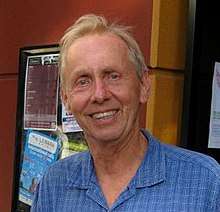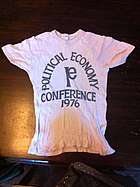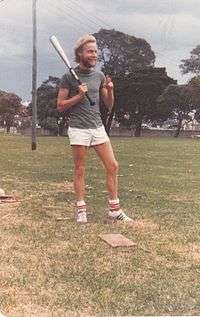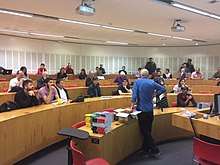Frank Stilwell (economist)
| Frank Stilwell | |
|---|---|
 | |
| Born | Southampton, England, United Kingdom |
| Nationality | English Australian |
| Alma mater |
University of Southampton (BSc) University of Reading (PhD) |
| Occupation | Emeritus Professor in Political Economy, University of Sydney |
| Awards |
University of Sydney, Award for Excellence in Teaching Fellow, Academy of the Social Sciences in Australia[1] |
Franklin "Frank" J.B. Stilwell (born 1945)[2] is an influential Australian political economist and professor emeritus. He is known for establishing, with Evan Jones, Gavan Butler, Margaret Power and Ted Wheelwright, an independent political economy department at the University of Sydney.[3] His research interests include theories of political economy, urbanisation and regional development, Australian economic policy and the nature of work.[4] His textbooks on the subject are standard teaching material for all university students in Australia studying the field of Political Economy.[5] Stilwell's contribution to heterodox economics makes him a noteworthy figure of the Australian New Left.[6]
Early life
Frank Stilwell was born in Southampton, in 1945. His mother was an infant school teacher, and his father was a junior clerk in the department of Customs and Excise.[7] His father enjoyed local politics and later became mayor. As Stilwell claimed in an interview with the Sydney Morning Herald: "[My father] was initially an independent... but he later joined the Conservative Party as a Conservative councillor. That was after the Conservatives threatened to stand a candidate against him … he was pragmatic till the end."[8]
Disputes within the University of Sydney Economics Department

Stilwell arrived at Sydney University in 1970, to an economics department that was deeply divided on the teaching of the qualitative and quantitative methods in economics. The roots of the dispute were framed by the rise of the new social movements of the late 1960s and the early 1970s, especially: the Anti-conscription campaigns surrounding the Vietnam war, the women’s movement, the (later) the anti-Springbok demonstration and the black rights protests. In politics, the election of Gough Whitlam forged the capacity for an alternative future for Australian economic governance. The crisis of stagflation and free education also had significantly impacted the political culture of the period. Dissident academic traditions were being forged in Paris and Berkeley challenging academic hierarchies; The New Left emerged to challenge the dominance of Orthodox Marxism, meanwhile the Green Bans showed the capacity for community and unionists coalitions. [9][10]
The 1960s economics syllabus had been dominated by a mix of microeconomics, macroeconomics (influenced by John Maynard Keynes), as well as the study of Australian and international economies. Colin Simkin and Warren Hogan were appointed to the Sydney University economics department in 1968-9. Both academics had been chosen by the Vice-Chancellor, Professor Bruce Williams who had previously been professor of economic as Manchester university. They would become the core figures pushing for a mathematical/theory orientated reform. Ted Wheelwright would write to the Vice-Chancellor in 1970, calling for an official enquiry into the department. Several of the academic hired by Hogan would end up aligning themselves with Wheelwright including: Debesh Bhattacharya, Gavan Butler, Frank Stilwell and Evan Jones. The issue was heightened when students began to complain that the new Economics I and Economics II courses were overly abstract and poorly taught. This would lead Simkin, in 1971, to requests the possibility of a Radical Economics course from 1973. This animosity was compounded when Paul Samuelson, arguably among the most influential economists of the period, came to lecture in Sydney. Samuelson’s lecture was met with much hostility, emptying most of the lecture theatre. As a response, a radical economics conference was organised by three students in 1973— Steve Keen, Richard Fields and Greg Cough.[11]

A large scale student and staff coalition would develop when the Philosophy Department decided to strike over the desire to teach a course in feminist and (in the previous year) a course dedicated to Marxist philosophy. The students in Economics I (being taught by Stilwell) votes to support the strike, emerging in the ‘day of protest’ on July 25, 1973 attend by 200 students. The students held a meeting, determining that they wanted a ‘political economy’ course, combining a range of insights from Heterodox economic thought. This lead to Pat Mills, a reader in the department of accounting, to set up an official enquiry. Mills found that the establishment of a Department of Political Economy would be the best solution, given that the economics department were unwilling to facilitate the changes to course content suggested by staff and students. The Faculty of economics resolved to endorse the Mills committee findings on 19 April 1974. Joan Robinson would come to speak in April 1975 at the Wallace Lecture Theatre in favour of the political economy movement. Malcolm Turnbull would emerge in 1975 as a key ‘mediator’ of the dispute, in favour of retaining a united economics department, to no avail. The Students’ Representative Council (SRC) in 1976, under the presidency of law student David Patch, would support the political economy push. The political economy conference of 1976 would attract 1500 people from all over Australia, largely fuelled by the Whitlam dismissal.[12]

In 1982/3 there was some fear that the Economics I(P) and possible Economics II(P) courses would be lost due to opinions emerging from the Vice-Chancellor. As a response, the SRC organised a vote on the forced merger, in which eighty per cent voted for the maintenance of separate streams. When this was not supported by the economics professorship, students organised a demonstration in the winter of 1983. On 8 June some students towed a rented caravan into the university grounds and parked it in the middle of the Quad’s Front Lawns. Adorned with a banner describing it as ‘the Faculty of Political Economy’ the caravan was used as an information centre for the protest movement. It stayed there for over three weeks, staffed day and night by political economy students such as Stephen Yen, Maria Barac and Paul Porteous. On 15 June students entered and occupied the clock tower in the Quadrangle. Damage, estimated by the university authorities at $96, was done to the hands on the western face of the clock. Then, on 20 June, student activists blocked the entrance to the professorial boardroom, adjacent to the Quadrangle, where the Academic Board was scheduled to consider what actions it would take in the absence of any agreement about course restructuring within the Department of Economics. After the students were prevailed upon to withdraw and the meeting began half an hour late, some of the protesters then climbed onto the roof of the cloister outside. University authorities initiated disciplinary proceedings against six activists: David Re, Adam Rorris, Tony Westmore, Daniel Luscombe, Chris Gration and Anthony Albanese.[13]

The restructuring of the faculty’s degree created the situation whereby, from 1987 onwards, all students studying economics at the University of Sydney had two possibilities open to them — enrolling for the BEc, with its compulsory mainstream economics and econometrics requirements, or enrolling for the BEc(SocSc) with the choice of doing either mainstream economics or political economy within that degree. Propaganda aimed at undermining the legitimacy of the new degree came from Groenewegen’s journalist friends McGuinness and Clark and also from former University of Sydney right-wing student leader Tony Abbott. By the 1990s, a range of third-year undergraduate options had been introduced and the fourth-year honours program was attracting excellent students. Steps had also been taken towards the development of postgraduate studies, with the introduction of a research-orientated Masters of Economics (Social Sciences) degree program in 1990 and, in 1999, a coursework Master’s degree that emphasised Australian political economy.[14] From 1996 onwards, the John Howard government dramatically cut universities’ funding, forcing them to vigorously seek alternative revenue sources. Attracting more international fee-paying students became the main game, and the Faculty of Economics and Business at the University of Sydney was particularly well placed as a big player. Disciplines such as business information systems and international business, were established. The result was that the School of Business became bigger and better resources than the School of Economics and Political Science. Within the latter school, the Discipline of Economic History was closed down in 2002. The Discipline of Political Economy was financially squeezed, partly because the number of international fee-paying students who enrolled in political economy was much lower than for the more directly business-orientated disciplines. There were some growth areas for political economy, though. the introduction in 2005 of a new degree, the Bachelor of International Studies, attracted a surge of good students to the study of political economy, as it became a compulsory core subject.[15]

The three years from 2004 to 2007 were very difficult for political economy, which was starved of funds because it did not bring in enough full fee-paying students (international or domestic). June Sinclair, a recently appointed Pro-Vice Chancellor with responsibilities for both the Faculty of Economics and Business and for the Faculty of Arts, sought to shift the Discipline of Government and international Relations from the former to the latter. Political Economy staff watched the process with interest, knowing that any such relocation would probably have ramifications for them too. Kvan’s committee produced its report at the start of 2007, recommending that a new School of Social Inquiry should be created in the Faculty of Arts and that the discipline of Political Economy and Government and International Relations be relocated to it, along with the existing Arts department of Sociology and Social Policy, Anthropology and the Centre for Peace and Conflict Studies. The recommendations were accepted by the provost and the University’s Academic Board, although Nutbeam decided that the new school should be change to Social and Political Sciences to accommodate the preference of the staff in Government and International Relations. From January 2008, Political Economy became a department in the Faculty of Arts. In 2011, students and staff of political economy successfully prevented a merger with Government and International Relations, retaining their departments independence.[16]
Academic Career at the University of Sydney
Frank Stilwell's research interests centre on Australian economic policies, urban and regional development and economic inequality. He is the author of eleven books, is coordinating editor of the Journal of Australian Political Economy,[17] and is on the editorial boards of Regional Studies, Social Alternatives, Australian Options and Industry and Innovation.[18] He was a colleague of Edward Lawrence Wheelwright,[19] who was also a prominent political economist who taught at the university until 1986. Some of the topics in Stilwell's works include urban and regional development, economic inequality, Australian economic policy and the contest of political economic ideas.[20]
Major contributions
Understanding Cities & Regions: Spatial Political Economy
Stilwell published 'Understanding Cities & Regions' in 1994, developing the theoretical foundations for spatial political economy. Taking inspiration from the work of David Harvey and Manuel Castells, Stilwell suggests that geography and political economy are capable of explaining processes of urbanisation. Political economy is defined as (but not limited to): (i) the analysis of how production, distribution and exchange are organised; (ii) how economic surplus is generated and the purpose for which is it used; (iii) the source of economic growth and recurrent crisis; (iv) economic inequality and class interests; (v) the role of the state in orchestrating economic activity.[21] Stilwell's contribution is thus to integrate these concerns into broader discussions of space and place related to the Urban Question: "“how and why does the size and structure of cities interact with the functioning of the economy and society?”[22]
— Stilwell interview with David Primrose, 2013 [23]
Reshaping Australia: Urban Problems and Policies
Throughout the course of the book, Stilwell identifies a range of policy areas within the field of spatial political economy. These include: (i) housing (ii) transport (iii) the environment (iv) inequality (v) gentrification (vi) the state (vii) regional policy (viii) decentralisation policy (ix) urban policy (x) urban consolidation (xi) development and monopoly capitalism (xii) urban conflict and protest. Together, these analytical fields, coupled with the theoretical considerations of Understanding Cities & Regions form the foundations of the distinct epistemology of spatial political economy. They epitomise the need to understand the connectivity of social and economic processes, and particularly, how these issues manifest at the level of policy in the age of Neoliberal governance.
Changing Track: A New Political Economic Direction for Australia
Stilwell published 'Changing Track' in 2000, offering a fourth way alternative to policy in the tradition of Political Economy. The book functions principally as a response to the popularisation of Third Way politics, identified by Boris Frankel as 'economic rationalism with a human face'[24]. In response, Stilwell suggests five elements are crucial in offering a political economic 'fourth way': (i) an appeal to equity; (ii) an appeal to planned use of economic resources; (iii) the promotion of institutionalised democracy; (iv) the recognition of common interests to promote cooperation; (v) an appeal to harmony between the economy and the environment.[25] John E. King, while broadly agreeing with the argument, has suggested that a hypothetical second edition to 'Changing Track' would also include considerations of: "the reform of monetary policy, the consequences of financialisation, the case for international economic reform, and the response to global warming."[26]
Public influence
— Anthony Albanese on the Political Economy disputes in the 1970s[27]
With a lecturing career spanning 40 years, many of Frank Stilwell's students have come to occupy prominent positions in Australian public life. In politics, these include: Mark Latham, Anthony Albanese, Greg Combet, Carmel Tebbutt, Michael Costa, Morris Iemma, Peter Kell (ASIC), and professors Steve Keen and Clive Hamilton. In Journalism: Stephen Long, Eleanor Hall, Jessica Irvine and Michael Janda. Stilwell estimated that he had taught 15,000 students by the time of his retirement.[28]
Bibliography
| Year | Title | Publisher |
|---|---|---|
| Political Economy Now! : The Struggle for Alternative Economics at the University of Sydney (Co-written with Gavan Butler and Evan Jones) | Sydney University Press | |
| Who Gets What?: Analysing Economic Inequality in Australia (Co-written with Jordan, K.) | Cambridge University Press | |
| Economics as a Social Science: Readings in Political Economy (Co-edited with G. Argyrous) | Pluto Press | |
| Political Economy: The Contest of Economic Ideas [29] | Oxford | |
| Changing Track: A New Political Economic Direction for Australia | Pluto Press | |
| Beyond the Market : Alternatives to Economic Rationalism (Co-edited with Stuart Reesand Gordon Rodley) | Pluto Press | |
| Economic Inequality: Who Gets What in Australia | Pluto Press | |
| Reshaping Australia: Urban Problems and Policies | Pluto Press | |
| Understanding Cities & Regions: Spatial Political Economy | Pluto Press | |
| The Accord and Beyond: The Political Economy of the Labor Government | Pluto Press | |
| Economic Crisis, Cities, and Regions | Pergamon Press | |
| Normative Economics: An Introduction to Microeconomic Theory and Radical Critiques | Pergamon Press | |
| Australian Urban and Regional Development | Australia and New Zealand Book Company | |
| Regional Economic Policy | Macmillan Press |
References
- ↑ "Fellows List - ASSA". Academy of the Social Sciences in Australia. Retrieved 23 January 2018.
- ↑ http://www.smh.com.au/nsw/an-inspiration-for-brightest-young-minds-20130329-2gz0j.html viewed 03/05/2017
- ↑ G Butler, E Jones, FJB Stilwell (2009) Political economy now!: The struggle for alternative economics at the University of Sydney Darlington Press
- ↑ http://sydney.edu.au/arts/political_economy/staff/profiles/frank.stilwell.php viewed 03/04/2017
- ↑ "Evatt Foundation: Frank Stilwell". Evatt Foundation. Retrieved 16 June 2011.
- ↑ Williams-Brooks, Llewellyn (2016). "Radical Theories of Capitalism in Australia: Towards a Historiography of the Australian New Left", Honours Thesis, University of Sydney, viewed 20 April 2017, https://ses.library.usyd.edu.au/handle/2123/16655
- ↑ http://www.smh.com.au/nsw/an-inspiration-for-brightest-young-minds-20130329-2gz0j.html viewed 03/05/2017
- ↑ http://www.smh.com.au/nsw/an-inspiration-for-brightest-young-minds-20130329-2gz0j.html viewed 03/05/2017
- ↑ G Butler, E Jones, FJB Stilwell (2009) Political economy now!: The struggle for alternative economics at the University of Sydney Darlington Press
- ↑ Mundey, J., 1981. Green bans & beyond. Angus & Robertson Publishers.
- ↑ G Butler, E Jones, FJB Stilwell (2009) Political economy now!: The struggle for alternative economics at the University of Sydney Darlington Press pp.1-13
- ↑ G Butler, E Jones, FJB Stilwell (2009) Political economy now!: The struggle for alternative economics at the University of Sydney Darlington Press, pp.14-47
- ↑ G Butler, E Jones, FJB Stilwell (2009) Political economy now!: The struggle for alternative economics at the University of Sydney Darlington Press, pp.60-65
- ↑ G Butler, E Jones, FJB Stilwell (2009) Political economy now!: The struggle for alternative economics at the University of Sydney Darlington Press, pp.79-84
- ↑ G Butler, E Jones, FJB Stilwell (2009) Political economy now!: The struggle for alternative economics at the University of Sydney Darlington Press, pp.90-91
- ↑ G Butler, E Jones, FJB Stilwell (2009) Political economy now!: The struggle for alternative economics at the University of Sydney Darlington Press, pp.94-103
- ↑ "Home Page". Journal of Australian Political Economy. JAPE. Retrieved 16 June 2011.
- ↑ "Staff: Professor Frank Stilwell". University of Sydney Department of Political Economy. USyd. Retrieved 16 June 2011.
- ↑ Stilwell, Frank. "Obit of Ted Wheelwright". History Cooperative. historycooperative.org. Retrieved 16 June 2011.
- ↑ "Profile of ASSA Member". Academy of the Social Sciences in Australia. ASSA. Retrieved 16 June 2011.
- ↑ Stilwell, F.J. and McArdle, E., 1994. Understanding cities & regions: spatial political economy. Royal Victorian Institute for the Blind. Special Request Service (p.16).
- ↑ Stilwell, F.J. and McArdle, E., 1994. Understanding cities & regions: spatial political economy. Royal Victorian Institute for the Blind. Special Request Service (p.28).
- ↑ https://www.worldeconomicsassociation.org/newsletterarticles/interview-with-frank-stillwell/ viewed 03/05/2017
- ↑ Frankel, Boris. "Beyond Labourism and Socialism: How the Australian Labor Party Developed the Model of'New Labour'." New Left Review 221 (1997): 3.Harvard
- ↑ Stilwell, F.J., 2000. Changing track: A new political economic direction for Australia. Pluto Press Australia. (p.126)
- ↑ King, J.E., 2014. Changing Track: Frank Stilwell’s ‘Fourth Way’After Thirteen Years. In Challenging the Orthodoxy (pp. 13-24). Springer Berlin Heidelberg.
- ↑ http://mpegmedia.abc.net.au/rn/podcast/2013/09/hht_20130901_1305.mp3 from 2:49-3:25
- ↑ http://www.smh.com.au/nsw/an-inspiration-for-brightest-young-minds-20130329-2gz0j.html viewed 03/05/2017
- ↑ Stilwell, Frank (2006). Political Economy: The Contest of Economic Ideas. South Melbourne: Oxford. ISBN 978-0-19-555127-3.
External links
- Stilwell's Ecop1001 lectures
- List of articles by Stilwell for the Conversation
- Journal of Australian Political Economy
- Political Economy Society Facebook Group
- World Economics Association Interview
- Interview in the Sydney Morning Herald